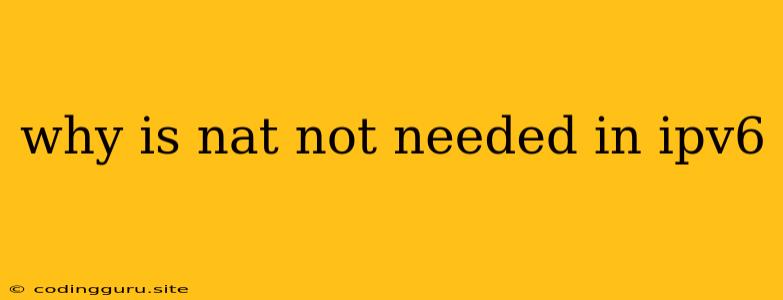Why Is NAT Not Needed in IPv6?
The transition from IPv4 to IPv6 has been a long and complex process. One of the major differences between the two protocols is the need for Network Address Translation (NAT). IPv4 heavily relies on NAT to conserve addresses, while IPv6 eliminates the need for it altogether. This significant change brings numerous advantages, simplifying network management and improving security.
But why is NAT not needed in IPv6? The answer lies in the massive address space available in IPv6 compared to IPv4.
The Address Space Difference
IPv4 utilizes a 32-bit address space, offering around 4.3 billion unique addresses. While this number seemed sufficient in the early days of the internet, the explosion of connected devices and the Internet of Things (IoT) quickly exhausted the available addresses. This scarcity led to the widespread use of NAT, a technique that translates private internal addresses to public external addresses, allowing multiple devices to share a single public IP address.
IPv6, on the other hand, uses a 128-bit address space, offering a mind-boggling 3.4 x 10^38 unique addresses. This vast pool of addresses effectively eliminates the need for NAT. Each device can have its own unique global IP address, simplifying network management and improving security.
Advantages of Eliminating NAT
1. Simplified Network Management:
- Without NAT, devices can communicate directly with each other without complex address translation, making network configuration and troubleshooting significantly easier.
- Network administrators no longer need to worry about NAT rules, port forwarding, and the associated complexity.
2. Enhanced Security:
- NAT often hides devices behind a single public IP address, making it difficult to identify and track individual devices. This can pose a security risk, as attackers can exploit the shared IP address to target multiple devices.
- IPv6 eliminates this security vulnerability by assigning a unique global address to each device, making it easier to identify and secure individual machines.
3. Improved Communication:
- NAT can sometimes interfere with communication, especially with applications that use specific port numbers. This is because NAT can modify the port numbers during translation, leading to unexpected behavior.
- IPv6 eliminates this issue by allowing direct communication between devices without any address manipulation.
4. Easier Peer-to-Peer (P2P) Networking:
- NAT can pose challenges for peer-to-peer applications as it hinders direct communication between devices.
- In IPv6, devices can easily connect and communicate with each other without the need for complex NAT configurations.
5. Reduced Network Overhead:
- NAT requires additional processing steps, introducing latency and potentially reducing network performance.
- IPv6 eliminates this overhead by simplifying communication and reducing the need for address translation.
Transition to IPv6
While IPv6 offers numerous advantages over IPv4, the transition to the new protocol has been slow. This is primarily due to the existing infrastructure, which is heavily reliant on IPv4. However, the increasing demand for IP addresses and the security benefits of IPv6 are driving the migration process.
Many organizations and countries have already transitioned to IPv6, and others are actively working towards it. It is important to note that even with the availability of IPv6 addresses, the use of NAT might still be required for specific scenarios, like connecting devices within a private network to the internet.
Conclusion
The elimination of NAT in IPv6 is a significant improvement over IPv4. It simplifies network management, enhances security, and improves overall communication efficiency. While the transition to IPv6 is ongoing, the benefits it offers are undeniable, leading to a more robust and secure internet.
